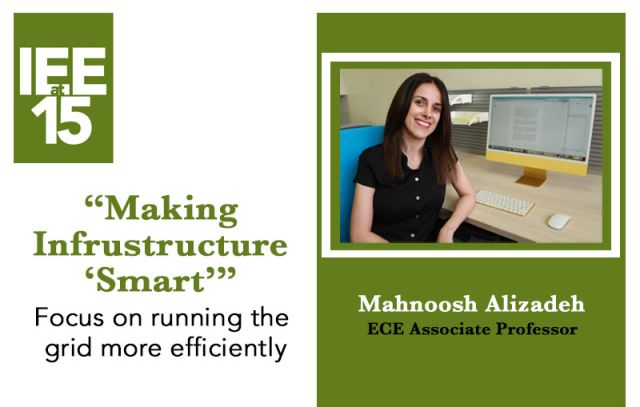IEE at 15 – "Smart" Infra
ECE Ass't. Prof. Mahnoosh Alizadeh aims to reshape how people consume electricity in their homes

Excerpt from the COE Convergence article "The Institute for Energy Efficiency at 15" (pg. 16)
The IEE was created as existentially significant questions about environmental sustainability were coming into sharper focus and becoming a larger part of the global conversation. The challenges presented have only deepened in the years between the institute’s founding and its fifteenth anniversary.
This segment from "The IEE at 15" presents a glimpse from the universe of research in the institute undertaken by ECE faculty.
"Making Infrastructure 'Smart'"
Mahnoosh Alizadeh aims to reshape how people consume electricity in their homes. An associate professor in UCSB’s Electrical & Computer Engineering Department, Alizadeh’s research is focused primarily on shifting demand behavior by designing data-driven incentives. With the increasing integration of renewable energy, especially at the grid edge, the electric grid faces significant stress in order to incorporate the additional uncertainty renewable energy brings in terms of generation outputs, posing serious risks to grid stability. Alizadeh says that addressing that challenge requires “re-imagining the end-use experience of how electricity delivery markets operate.”
Her work falls within the Smart Societal Infrastructure (SSI) research pillar, but is very much related and complementary to concepts underlying research in the FEWN pillar. SSI research is focused on the operations of the power grid, the components it comprises, and the interplay of the grid with the wide variety of societal systems that attach to it, such as electric transportation networks. IEE’s research programs in the SSI pillar explore a variety of approaches to improving the power grid and its components.
Alizadeh employs a variety of tools including optimization, data-driven learning, machine learning, and game theory in trying to understand how to motivate human beings to make decisions aligned with sustainability. “For instance, how might we coordinate users to be more flexible, so that they consume more solar energy or wind energy as it is produced in the grid, since those types of energy are hard to control, and it is expensive to store the energy they produce,” she queries. “Or, how can we get consumers to charge their electric vehicles at the right time and location in terms of energy availability? That is clearly a highly interdisciplinary problem, because it involves human behavior and decision-making, how we operate the power system, real-time data streaming, and so on, and, thus, a variety of tools are required to model and address it.”
Alizadeh is also involved in examining how to use data-driven machine learning to understand customer behavior and fine-tune operations for supplying power and other critical infrastructure services. Off-the-shelf tools lack the safety-critical constraints necessary in operating the power system, which she describes as “basically a very large circuit with hard physical constraints that have to be met at every instant.”
Since data-driven learning and control algorithms essentially learn by trying things and then seeing the outcome and can’t know what will happen until they do, “The major problem,” Alizadeh says, “is what if the ‘trial’ outcome violates the safety-critical constraints of the power system? Developing machine-learning algorithms dedicated to systems that have hard physical constraints has been my group’s major focus for the past two years.”
COE/CLS Convergence magazine (Summer 2024) - "The IEE at 15" (full article pgs. 12-17)